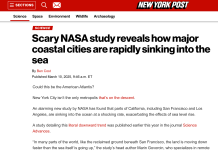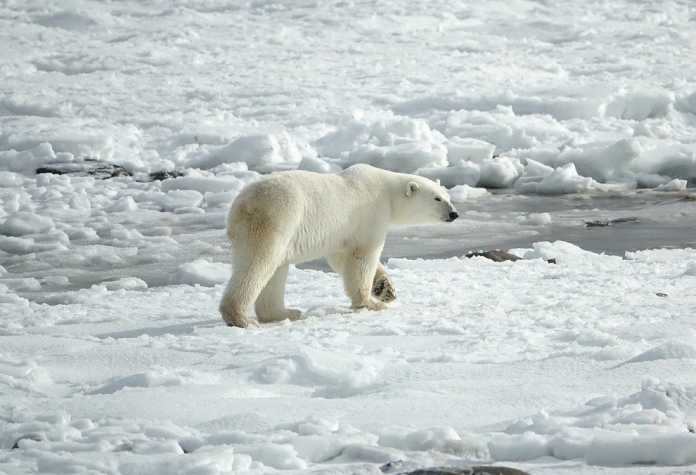A Google News search of the phrase “climate change,” today turns up a story in Inside Climate News claiming polar bears are declining due to climate change. Nothing could be further from the truth. Data show polar bear numbers have grown significantly during the recent modest warming.
The story, “Warming Trends: Climate Threats to Bears, Bugs and Bees, Plus a Giant Kite and an ER Surge,” covered a lot of topics, not all of them related directly to climate change. The first section of the story, however, claimed later than usual freezing conditions in the Hudson Bay in 2021 threatened the polar bear populations there.
Inside Climate News writes:
The Hudson Bay in northern Canada froze up later than normal this year, delaying polar bears’ hunting season by two to three weeks, a nonprofit polar bear conservation organization found.
When the ice on the bay is thick enough, polar bears living in the Hudson Bay migrate out onto the ice to hunt for seals.
Last year marked the second-latest freeze up on record of the Hudson Bay, after 2010.
Contrary to what is implied in the Inside Climate News story, data show polar bear numbers across the arctic region and for most sub-populations have increased dramatically since the 1970s, during the period of modest warming. The increase has occurred despite waxing and waning sea ice extent and normal historical variation in freeze up dates.
Research presented in Climate at a Glance: Polar Bears shows polar bear populations have increased dramatically during recent decades as the planet has warmed, quadrupling since 1950s. Polar bear populations have rised from between 5,000 and 10,000 bears in 1950 to between 22,000 and 31,000, today based on an estimate of the Polar Bear Monitoring Group.
Polar Bear researcher Susan Crockford, Ph.D., puts the present number of polar bears even higher writing in her report, State of The Polar Bear Report 2020:
[A] plausible and scientifically defensible ‘best-guess’ estimate at 2018, extrapolated from ‘known’ to ‘unknown’ subpopulations within sea ice ecoregions …, would be about 39,000 (range 26,000-58,000), although a more pessimistic best-guess based on a greater variety of ecosystem traits (including prey diversity and sea ice cover) came out much lower, at 23,315 (range 15,972-31,212).
Polar bears evolved between 6 million years ago and 350,000 years ago, surviving and thriving in much warmer climate than today. Most recently, polar bears survived during the Holocene climatic optimum, from 9000 to 5000 years ago, which proxy data indicate was much warmer than at present.
Breaking the polar bear population numbers down by subpopulations, of which polar bear experts count 19 based on the different eco-regions they inhabit, 14 populations are best considered “presumed stable or increasing,” two subpopulations have “increased” or “likely increased,” and populations in three ecoregions are “stable or likely stable,” Crockford’s survey of the literature shows.
Inside Climate News restricts its reporting to the polar bear subpopulation in the Hudson Bay, saying Polar Bear International reports, in 2021, the ice did not form until early December which was the 2nd latest freeze up since detailed records have been kept in the Hudson Bay. Yet in 2020, Crockford reports, “the freeze-up of sea ice on Western Hudson Bay came as early in the autumn as it did in the 1980s (for the fourth year in a row) and sea-ice breakup in spring was also like the 1980s; polar bears onshore were in excellent condition.” Annual fluctuations in the timing and extent of sea ice formation are normal.
Inside Climate News fails to distinguish between the Southern Hudson Bay and the Western Hudson Bay polar bear subpopulations. Crockford’s report indicates although seasonal polar bear populations declined in the Western Hudson Bay between 1987 and 2004, their numbers have stabilized since then. The seasonal Southern Hudson Bay sub-population has been stable at around 1,000 bears since the 1980s. Contrary to later forming sea ice representing a threat to polar bear survival and thriving, Crockford reports:
Primary productivity in the Arctic has increased since 2002 because of longer ice-free periods (especially in the Laptev, East Siberian, Kara, and Chukchi Seas, but also in the Barents Sea and Hudson Bay), but hit records highs in 2020; more fodder for the entire Arctic food chain explains why polar bears, ringed and bearded seals, and walrus are thriving despite profound sea ice loss.
Groups, like PBI, fundraising off of the threat climate change supposedly poses to polar bears, have been warning of an impending collapse in polar bear numbers for nearly three decades now. Their predictions are refuted by the measured increase in polar bear numbers. Polar bears are thriving amidst modest warming: a fact, Inside Climate News, if it were being honest, would be reporting.

















If you adapt too strongly to an environmental niche, there is always a danger that your niche will disappear, and you with it, but as Patrick Moore has said, Ursus Maritimus is an evolved Grizzly, and is adapted to the sea and shore, not to ice and snow, so even with no ice, they can stalk the shores where their prey hauls out and find a meal. Also, with infra-red sensing satellites it can’t be hard to spot warm-blooded bears all over the Arctic, as they use visual camouflage to stalk, not trees.
CLIMATE CHANGE is one of the Left’s sacred cows. On Jan. 5, 2022 an article was published in Geophysical Research Letters titled: Supernova Rates and Burial of Organic Matter. The article reveals how complicated the phenomena are that ultimately drive climate change. The final sentence reads:
“The evidence points to an extraordinary interconnection between life on Earth and star formation, mediated by the effect of cosmic rays on clouds and climate.”
https://agupubs.onlinelibrary.wiley.com/doi/10.1029/2021GL096376
Also discussed here:
https://phys.org/news/2022-01-supernovae-life-earth.html
Irony is seldom this delicious.